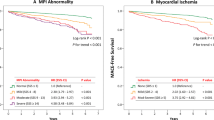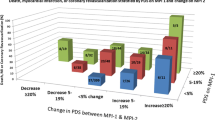Abstract
Background
Total and reversible left ventricular (LV) perfusion defect size (PDS) predict patient outcome. Limited data exist as to whether regadenoson induces similar perfusion abnormalities as observed with adenosine. We sought to determine whether regadenoson induces a similar LV PDS as seen with adenosine across varying patient populations.
Methods and Results
ADVANCE MPI were prospective, double-blind randomized trials comparing regadenoson to standard adenosine myocardial perfusion tomography (SPECT). Following an initial adenosine SPECT, patients were randomized to either regadenoson (N = 1284) or a second adenosine study (N = 660). SPECT quantification was performed blinded to randomization and image sequence. Propensity analysis was used to define comparability of regadenoson and adenosine perfusion results. Baseline clinical and SPECT results were similar in the two randomized groups. There was a close correlation between adenosine and regadenoson-induced total (r 2 = 0.98, P < .001) and reversible (r 2 = 0.92, P < .001) PDS. Serial differences in total (0.00 ± 3.51 vs −0.11 ± 3.46, P = .51) and reversible (0.15 ± 3.79 vs 0.07 ± 3.33, P = .65) PDS were also comparable in patients randomized to regadenoson vs adenosine, respectively, and irrespective of age, gender, diabetic status, body mass index, or prior cardiovascular history. By propensity analysis, regadenoson-induced total PDS was significantly larger than observed with adenosine.
Conclusion
This is the first study to show that regadenoson induces similar, if not larger, perfusion defects than those observed with adenosine across different patient populations and demonstrates the value of quantitative analysis for defining serial changes in SPECT perfusion results. Regadenoson should provide comparable diagnostic and prognostic SPECT information to that obtained with adenosine.



Similar content being viewed by others
References
Zoghbi GJ, Iskandrian AE. Coronary artery disease detection: pharmacologic stress. In: Zaret BL, Beller GA, editors. Clinical nuclear cardiology: State of the art and future directions. 3rd ed. Philadelphia: Elsevier Mosby; 2005. p. 233-53.
Shaw LJ, Iskandrian AE. Prognostic value of gated myocardial perfusion SPECT. J Nucl Cardiol 2004;11:171-85.
Mahmarian JJ, Shaw LJ, Filipchuk NG, Dakik HA, Iskander SS, Ruddy TD, et al. A multinational study to establish the value of early adenosine technetium-99m sestamibi myocardial perfusion imaging in identifying a low-risk group for early hospital discharge after acute myocardial infarction. J Am Coll Cardiol 2006;48:2448-57.
Nabi F, Chang SM, Xu J, Gigliotti E, Mahmarian JJ. Assessing risk in acute chest pain: The value of stress myocardial perfusion imaging in patients admitted through the emergency department. J Nucl Cardiol 2012;19:233-43.
Mahmarian JJ, Cerqueira MD, Iskandrian AE, Bateman TM, Thomas GS, Hendel RC, et al. Regadenoson induces comparable left ventricular perfusion defects as adenosine. A quantitative analysis from the ADVANCE MPI 2 Trial. J Am Coll Cardiol CV Imaging 2009;2:959-68.
Iskandrian AE, Bateman TM, Belardinelli L, Blackburn B, Cerqueira MD, Hendel RC, et al. Adenosine versus regadenoson comparative evaluation in myocardial perfusion imaging: results of the ADVANCE phase 3 multicenter international trial. J Nucl Cardiol 2007;14:645-58.
Hansen CL, Goldstein RA, Akinboboye OO, Berman DS, Botvinick EH, Churchwell KB, et al. Myocardial perfusion and function: single photon emission computed tomography. J Nucl Cardiol 2007;14:e39-60.
Ficaro EP, Lee BC, Kritzman JN, Corbett JR, Corridor DM. The Michigan method for quantitative nuclear cardiology. J Nucl Cardiol 2007;14:455-65.
Mahmarian JJ, Moye LA, Verani MS, Bloom MF, Pratt CM. High reproducibility of myocardial perfusion defects in patients undergoing serial exercise thallium-201 tomography. Am J Cardiol 1994;75:1116-9.
Shaw LJ, Berman DS, Maron DJ, Mancini GB, Hayes SW, Hartigan PM, et al. Optimal medical therapy with or without percutaneous coronary intervention to reduce ischemic burden: results from the Clinical Outcomes Utilizing Revascularization and Aggressive Drug Evaluation (COURAGE) trial nuclear substudy. Circulation 2008;117:1283-91.
Mahmarian JJ, Dakik HA, Filipchuk NG, Shaw LJ, Iskander SS, Ruddy TD, et al. An initial strategy of intensive medical therapy is comparable to that of coronary revascularization for suppression of scintigraphic ischemia in high-risk but stable survivors of acute myocardial infarction. J Am Coll Cardiol 2006;48:2458-67.
Mahmarian JJ. Monitoring Medical Therapy: The role of noninvasive imaging. In: Dilsizian V, Narula J, Braunwald E, editors. Atlas of nuclear cardiology. 2nd ed. Philadelphia, PA: Current Medicine; 2006. p. 191-210.
Iqbal FM, Hage FG, Ahmed A, Dean PJ, Raslan S, Heo J, et al. Comparison of the prognostic value of normal regadenoson with normal adenosine myocardial perfusion imaging with propensity score matching. J Am Coll Cardiol Imaging 2012;5:1014-21.
Bhatti S, Hakeem A, Dhanalakota S, Palani G, Husain Z, Jacobsen G, et al. Prognostic value of regadenoson myocardial single-photon emission computed tomography in patients with different degrees of renal dysfunction. Eur Heart J Cardiovasc Imaging 2014;15:933-40.
Wilson RF, Wyche K, Christensen BV, Zimmer S, Laxson DD. Effects of adenosine on human coronary arterial circulation. Circulation 1990;82:1595-606.
Belardinelli L, Shryock JC, Snowdy S, Zhang Y, Monopoli A, Lozza G, et al. The A2A adenosine receptor mediates coronary vasodilation. J Pharmacol Exp Ther 1998;284:1066-73.
Cerqueira MD. The future of pharmacologic stress: Selective A2A adenosine receptor agonists. Am J Cardiol 2004;94:33D-42D.
Lieu HD, Shryock JC, von Mering GO, Gordi T, Blackburn B, Olmsted AW, et al. Regadenoson, a selective A2A adenosine receptor agonist, causes dose-dependent increases in coronary blood flow velocity in humans. J Nucl Cardiol 2007;14:514-20.
Kaul S, Jayaweera AR. Coronary and myocardial blood volumes. Non-invasive tools to assess the coronary microcirculation? Circulation 1996;96:719-24.
Cerqueira MD, Nguyen P, Staehr P, Underwood SR, Iskandrian AE, On Behalf of the ADVANCE-MPI Trial Investigators. Effects of age, gender, obesity, and diabetes on the efficacy and safety of the selective A2A agonist regadenoson versus adenosine in myocardial perfusion imaging: Integrated ADVANCE-MPI trial results. J Am Coll Cardiol CV Imaging 2008;1:307-16.
Xu Y, Hayes S, Ali I, Ruddy TD, Wells RG, Berman DS, et al. Automatic and visual reproducibility of perfusion and function measures for myocardial perfusion SPECT. J Nucl Cardiol 2010;17:1050-7.
Prenner BM, Bukofzer S, Behm S, Feaheny K, McNutt BE. A randomized, double-blind, placebo-controlled study assessing the safety and tolerability of regadenoson in subjects with asthma or chronic obstructive pulmonary disease. J Nucl Cardiol 2012;19:681-92.
Ananthrasubramaniam K, Weiss R, McNutt B, Klauke B, Feaheny K, Bukofzer S. A randomized, double-blind, placebo-controlled study of the safety and tolerance of regadenoson in subjects with stage 3 or 4 chronic kidney disease. J Nucl Cardiol 2012;19:319-29.
Rosenblatt J, Mooney D, Dunn T, Cohen M. Asystole following regadenoson infusion in stable outpatients. J Nucl Cardiol 2014. doi:10.1007/s12350-014-9898-0.
Disclosure
Drs Mahmarian, Cerqueira, and Thomas are consultants and on the Speakers Bureau for Astellas Pharma, Inc. Dr Bateman has served on Astellas Advisory Boards and has received grant research support from Astellas. The other authors have no conflict of interest.
Author information
Authors and Affiliations
Corresponding author
Additional information
Funding
This trial was funded by Astellas Pharma US (Astellas Scientific and Medical Affairs; 1 Astellas Way, Northbrook IL 60062).
Alberto Cuocolo, MD, served as the Guest Editor for this article.
See related editorial, doi:10.1007/s12350-014-0003-5.
Rights and permissions
About this article
Cite this article
Mahmarian, J.J., Peterson, L.E., Xu, J. et al. Regadenoson provides perfusion results comparable to adenosine in heterogeneous patient populations: A quantitative analysis from the ADVANCE MPI trials. J. Nucl. Cardiol. 22, 248–261 (2015). https://doi.org/10.1007/s12350-014-9981-6
Received:
Accepted:
Published:
Issue Date:
DOI: https://doi.org/10.1007/s12350-014-9981-6




